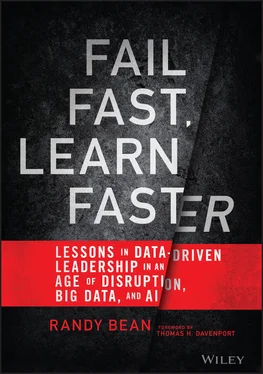Referencing statistics drawn from the U.S. Department of Commerce, Gartner, and additional sources, SVB concluded that Big Data maturity is highest in smaller-sized markets, like advertising and travel, and is at an early stage or nascent in the large economic markets, like financial services and healthcare. They cited two significant impediments to Big Data spending in these markets: level of regulatory oversight and ease of data capture.
Despite sizable investments at the time in Big Data from some large financial services and healthcare companies, Silicon Valley Bank concluded that the Big Data industry was at the tip of the iceberg (“nascent”) in terms of future investment opportunities. SVB foresaw a future driven by Big Data investment in “high friction, high value” industries. Chris Parsons, a speaker at the SVB event, and who served as vice president, Big Data Strategy, for AT&T from 2014 to 2019, related that “the use cases may not always be sexy,” but the “business impact can be enormous.” 19 AT&T had recently opened a dedicated Big Data center of excellence in Plano, Texas, with the goal of bringing speed and agility to its business capabilities and processes. For AT&T, Big Data meant dealing with 10 million columns of structured data for 62,000 services.
A decade after the advent of Big Data, SVB has proved to be correct. Mainstream companies are driving the future of Big Data investment. It is not all classic disruption and glamorous tales. However, when measured by investment and business value, the impact of Big Data transformation efforts has been massive and at scale. Big Data has become an integral part of the mainstream for large corporations as they have come to appreciate that Big Data means faster time-to-market, quicker response to customer needs and interests, and the opportunity to accelerate time-to-value through greater speed and agility.
The business value of data has come to be well recognized and accepted at the board and within the C-suite as its complexity has been made understandable and digestible in fundamental business terms. There has been a growing recognition and acknowledgment of data as a business asset that is critical to measurement, insight, and differentiation. Ash Gupta, president, Global Credit Risk and Information Management, at American Express for 41 years prior to his retirement in 2018, notes that AMEX had focused its early Big Data effort on three areas: service excellence, generating billings and receivable growth, and risk management, commenting, “Big Data analytics have helped us significantly reduce the lag time to insight and discovery, allowing us to more rapidly enhance customer experience.” 20
Jim Smith, executive vice president and head of Enterprise Data and Analytics at Wells Fargo from 2011 to 2014, and later head of all digital channels, noted at the time that “We're focused on not just Big Data, but using our data faster and more effectively. Our customers interact with us in many different channels and there has been tremendous data growth with the surge of online and mobile banking.” Smith added, “We are looking at how customers interact with us across all touch points – digital, phone, ATM and inside the store. This activity allows us to see new patterns to help improve our service or help a customer find the right product or identify fraudulent behaviors. Big Data technologies will allow us to become more proactive on behalf of our customers.” 21
Today, companies are focusing on the business benefits that Big Data can bring. How can we go to market faster? How can we increase revenues or reduce costs? How can we win more business? Once data experts learned to translate and communicate complex technical or scientific jargon in terms of basic outcomes – win, lose, fast, outsell, grow – the business value and benefit of data gained traction and greater appreciation. As Big Data has gained acceptance, even the most mission-critical operational and regulatory reporting applications have been transformed, as higher-cost production processes are migrated to lower-cost platforms. Big Data has fundamentally changed the time and cost equation for many business activities.
Dick Mucci, retired president, Group Protection at Lincoln Financial, former chairman and CEO of New York Life International, sums up how the emergence of Big Data has created new visions of business opportunity. In the future, says Mucci, “the availability and analysis of data will become the competitive lifeblood for businesses.” He adds, “The promise of Big Data is that when the winners and losers are sorted out, businesses find themselves on the right side of the ledger. Data-driven business models are not just nice to have, they are essential.” 22
Businesses have made substantial investments in new data and analytics approaches. They will now be expected to demonstrate measurable impact and business benefit from these investments. Big Data is no longer the “new, new thing.” As we shall see, realization of these benefits will require cultural changes that impact people, organizations, and business processes.
1 1. Michael Lewis, Moneyball: The Art of Winning an Unfair Game (W.W Norton, 2003).
2 2. Thomas H. Davenport, Only Humans Need Apply: Winners and Losers in the Age of Smart Machines (Harper, 2016).
3 3. James Manyika, Michael Chui, Brad Brown, Jacques Bughin, Richard Dobbs, Charles Roxburgh, and Angela Hung Byers, “Big Data: The Next Frontier for Innovation, Competition, and Productivity,” McKinsey Digital, May 2011.
4 4. Leena Rao, “Accel Debuts $100M Fund to Invest in Disruptive Big Data Companies,” TechCrunch, November 8, 2011.
5 5. Randy Bean, “The Legacy of Big Data,” Wall Street Journal, September 9, 2014.
6 6. Ibid.
7 7. Colleen Taylor, “Accel Launches $100M Big Data Fund 2 to Invest in the Second Wave of Big Data Startups,” TechCrunch, June 17, 2013.
8 8. VCCircle.com, “Accel Partners Raises $100 Million for Second Big Data Fund,” Reuters, June 19, 2013.
9 9. Presentation and remarks by Michael Stonebraker at the MIT Chief Data Officer and Information Quality (CDOIQ) Symposium, Cambridge, MA, August 2015.
10 10. Erik Brynjolfson and Andrew McAfee, “Big Data: The Management Revolution,” Harvard Business Review, October 2012.
11 11. Liran Einav and Jonathan D. Levin, “The Data Revolution and Economic Analysis,” The National Bureau of Economic Research, May 2013.
12 12. “Exploring the Big Data Revolution,” APICS: The Association for Supply Chain Management, 2015.
13 13. Tricia Bisoux, “B-Schools Respond to the Data Revolution,” BizEd, December 30, 2018.
14 14. Jared Kaltwasser, “Experts: Big Data ‘Revolution’ Won't Materialize Until Healthcare Fixes 1 Big Problem,” Inside Digital Health, February 20, 2019.
15 15. Christopher Phillips, “If Baseball Is Any Indication, the Big Data Revolution Is Over,” Washington Post, July 9, 2019.
16 16. Randy Bean, “The ‘Failure’ of Big Data,” Forbes, October 20, 2020.
17 17. Thomas H. Davenport, “Even Small Data Can Improve Your Organization's Judgment,” Harvard Business Review, May 26, 2012.
18 18. Thomas H. Davenport, Big Data @ Work: Dispelling the Myths, Uncovering the Opportunities (Harvard Business Review Press, 2014).
19 19. Randy Bean, “Big Data Sparks a New Industrial Age,” Wall Street Journal, January 15, 2015.
20 20. Randy Bean, “How American Express Excels as a Data-Driven Culture,” Forbes, March 15, 2018.
21 21. Randy Bean, “Big Data Innovation: Fail Faster. Execute Smarter.” Wall Street Journal, February 18, 2014.
22 22. Bean, “The Legacy of Big Data.”
Конец ознакомительного фрагмента.
Читать дальше












